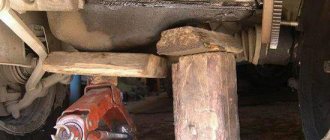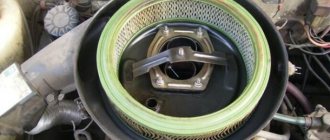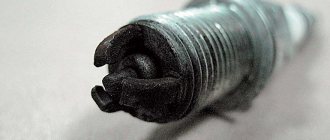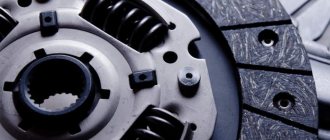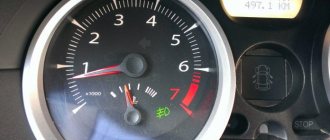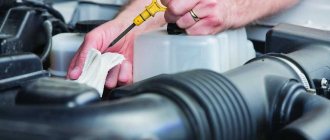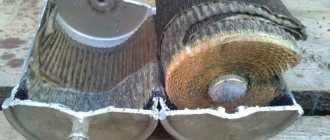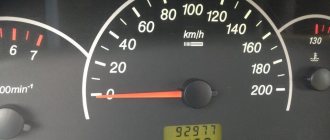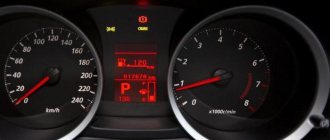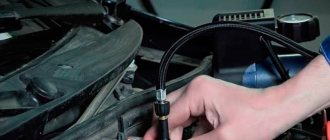Hi all. Today's article will be devoted to the clutch, or rather its malfunction. We'll talk about why the clutch pedal fails, the reasons why it happens, and how to fix it.
The trouble with a clutch failure is that shifting gears becomes impossible, which means driving such a car is out of the question. The first question that arises in your head is: “How to get to the service station when the clutch pedal has failed”?
Let's figure it out; naturally, we'll take domestic VAZs as an example, since our site is dedicated to cars of this particular brand.
First of all, let’s clarify something... If anyone doesn’t know, then VAZ from 2101 to 2107 has a hydraulic clutch, “, , and”, as well as “Kalin”, etc. have a “cable” clutch.
Features of the VAZ 2112 clutch
The machine is equipped with a dry-type single-plate friction clutch with a central pressure spring. adjusting the clutch on Kalina any motorist must take into account that the control pedal is connected to the disc via a cable with a special ratcheting mechanism.
How does automatic cable tightening work?
As a result of intensive use, the friction linings of the disc gradually wear out. The ratcheting mechanism built into the drive design allows you to compensate for wear for a certain period of time - it gradually tightens the cable. During operation of the device, the fork rotates and the bushing spring is gradually compressed. As a result, the cable end clamps are compressed, after which the latter is released and tensions the cable.
The purpose of this design is to facilitate the maintenance process. According to the plans of VAZ engineers, the mechanism should save the owner from the need to make adjustments himself. But this is all only in theory, but in practice it turns out that you cannot do without adjusting the clutch.
When should adjustments be made?
Before adjusting the clutch on a Kalina car, you need to determine the moment when the automatic cable locking no longer functions. This is not difficult, especially since the machine itself signals problems:
- Loss of traction, friction clutch does not provide a reliable connection between the flywheel and the disk. The consequence of such a defect will be the loss of a significant part of the torque force.
- The clutch control pedal does not return to its initial position, which, in fact, is a consequence of the first point.
- Poor clutch disengagement - the pedal is not pressed all the way, which makes changing gears difficult.
The symptoms, however, are similar to those when clutch adjustment is needed on a VAZ 2107 , so experienced motorists can skip this unit and proceed directly to the test.
How to check the clutch?
To make sure that the mechanism needs to be adjusted, you should perform a number of basic checks:
- Press the pedal several times and release - any extraneous sounds are unacceptable. For better control, you can press with your hand, this way you can feel the pedal stroke more fully.
- Check the pedal for sticking; if it returns with noticeable twitching, then adjustment is necessary.
- Check the full travel of the pedal using a ruler or tape measure. Press and release the pedal several times, then measure the distance of its outer edge to the floor; if it is more than 146 mm, then the mechanism needs to be adjusted.
- Check the movement of the cable guide relative to the clutch release fork; the maximum distance between these elements is 27 mm.
- If the runout of the driven disk linings is more than 0.5 mm, adjustment is also required.
When performing checks, it is important that the car engine is turned off.
Causes of failure
Clutch problems are a common problem with cars, caused primarily by improper use and wear of parts. Be that as it may, to troubleshoot the problem, it is important to know the reasons why the clutch pedal fails.
There are several of them:
1. Cable break. One of the most common problems is damage to the clutch cable. The weak point is in the tip area where the cable is connected to it in the engine compartment. The solution to this problem is to replace the cable, which can be done without the involvement of specialists. How to eliminate clutch pedal failure will be discussed below.
2. Breakage of the return spring. During operation, the spring mechanism that ensures the return of the lever to the upper position often fails. If the spring breaks, the only solution is to replace it. Replace it locally or at a service station.
Broken clutch pedal spring
There are situations when the spring simply falls off. In this case, find it and install it in place. After this, check the clutch operation and continue driving.
3. Air entering the hydraulic drive - for VAZ 2101-07 vehicles. If such a malfunction occurs, bleed the system. If there is no suitable tool, then call a tow truck or a garage.
4. Failure of the release fork. This unit is mounted on the car’s gearbox, and its service life is not that long. What to do if the clutch pedal fails due to a broken unit? The solution is to replace the failed element. When performing work, check the condition of the clutch disc and also change it if necessary.
5. Problems with the master cylinder. Situations are possible when one of the cylinders “pierces”, defects appear on it or the cuff is torn. If pedal failure is caused by this fault, all is not lost. Press the control lever sharply several times, after which the latter can return to its place.
6. Failure of the driven disk. If clutch pedal failure is caused by a failed disc, diagnosing the cause is easy. In this case, the pedal becomes pliable and soft. The malfunction is often caused by deformation of the unit, broken drive disk, leakage or mechanical damage.
Without noise and dust: how to properly adjust the clutch on a Kalina station wagon yourself?
You should start working no earlier than the engine has completely cooled down. The setup method is simple and does not require a visit to a car service center, because you can do everything yourself. The step-by-step scheme for completing the work is as follows:
- Before adjusting the clutch drive on Kalina, you should open the engine compartment hood and remove the air filter.
- Visually assess the condition of the cable casing and replace it if damaged.
- Pull the tip toward you until the cable is fully tensioned. After this, check the distance between the fork and the leash with a caliper.
- If the measurements show more than 27 mm, then the distance is corrected by rotating the leader along the thread of the tip.
- Press and release the clutch pedal several times and repeat the measurements.
- If necessary, repeat the adjustment until the required standards are achieved.
The technology for setting up the clutch on Kalina is not as complicated as installing the VAZ 2110 clutch , therefore it is quite feasible in a garage environment without the involvement of specialists. And this fact pleases domestic motorists, because the clutch plays an important role in driving a car.
How to get to the nearest service station or home if the clutch pedal has failed?
The task, although not easy, is still quite realistic. The main thing here is to get going and not take your foot off the gas, maintaining the speed in first gear.
You need to proceed as follows
We warm up the engine, turn on the emergency lights, then turn on first gear, and turn the key in the ignition. When the engine starts to “catch”, give the gas and start moving. With the right approach, the car will not stall, and you will be able to move away and slowly get to your destination. Don't try to change gear without a clutch - it is certainly possible, there is a technique, but without the proper skill you will most likely stall or damage your transmission.
Now you know why the clutch pedal does not return, for what reasons this happens and how to solve this problem. In addition, if this happens, you will know how to get home if the VAZ clutch pedal fails. That's all for me, write in the comments how you solved this problem and what signs of malfunction you had and the cause of the breakdown. Thank you all for your attention and see you again at VAZ Repair. Bye!!!
Replacing and adjusting the clutch cable on a viburnum
Welcome! Clutch cable - thanks to it, you can control the clutch fork, and at that moment it can disconnect the clutch from the flywheel, thanks to the release bearing, a cable is used on all front-wheel drive cars, because their gearbox is located deep in the front, on classics Together with the cable, the main and slave cylinders of the clutch are used (there is no clutch cable), these cylinders work differently, unlike the cable (the cable simply pulls), but the result is the same (the clutch is disconnected from the flywheel due to the release bearing) and the effect occurs due to one and the same unit, namely thanks to the clutch pedal.
Driving without a clutch: what you need to know
Taking into account the fact that most breakdowns that are associated with the clutch or clutch pedal (for example, the clutch pedal has failed) can take the driver by surprise, and it is often impossible to fix problems on the spot, the only option is to drive to the service station under your own power.
At the same time, we draw your attention once again to the fact that the methods described below should be used only in cases of extreme necessity, since the risk of damaging the box or getting into an accident increases significantly.
- So, first you need to turn off the car engine. If you lose traction on a hill, you should push the car onto a level road. Then it is recommended to think over the route in advance so that, if possible, you travel along a route with a minimum number of traffic lights, pedestrian crossings, not congested with traffic, so that you do not have to stop often, etc.;
- Next, with the engine turned off, you should engage first gear, and you also need to turn on the emergency lights, after which the engine can be started (note that the car will jerk forward sharply immediately after turning the key in the ignition switch to the “start” position);
Let us also add that beginners in such a situation should be prepared for the fact that the engine will stall when it comes to a complete stop or greatly reduces the speed without turning off first gear. This means that in this case you will have to start again on the first one.
This is possible if the driver feels when engaging a gear without a clutch with minimal effort can, without much risk, seriously damage the gearbox and transmission parts, taking into account engine speed and speed. However, if you try to do this without experience and skills, there is a high risk of damaging the gearbox, significantly reducing the life of the unit, or completely destroying the gearbox and other transmission elements.
Why and where do the pedals on the VAZ-2110 fail?
Tens clutch diagram. There was nothing new for those times!
Of course, everyone who drives a VAZ-2110 knows the structure of the single-plate dry clutch mechanism and its drive. As on all inexpensive cars, the simplest clutch is not activated hydraulically, but mechanically: we press pedal 9, the pedal pulls the cable, the cable drives the fork 4, and the fork pushes the release bearing 13, which acts on the blades of the pressure plate 6 The release disk is removed from the driven disk 7, the clutch is disengaged.
If at least one of the elements of this chain loses its properties (strength, elasticity, integrity), the pedal simply falls to the floor or the clutch does not disengage, partially or completely. Let's look at the most common faults typical for machines of the tenth family.
What to do if the gear shift mechanism does not work?
If the clutch pedal fails on a road with heavy traffic, you should not be nervous, but act calmly with a “cool head” and get to the nearest parking spot, or even better, to a garage or service station. To do this, you can use a tug, tow truck, or drive yourself.
How to drive independently if the clutch system breaks down?
You can use the following tips from proven car enthusiasts:
You can also drive to the repair site with a VAZ2106 or VAZ2107 car without a clutch, engaging second gear in the same way when starting to drive. Only in this case it is necessary to take into account some important nuances:
- the car should be either on a horizontal section or on a downhill slope, but not uphill. If the car goes uphill, then this method will not work; Before you start driving, you need to warm up the engine;
- Since the car will move in a lower gear no higher than second, you should carefully think through the route so that you do not have to stop at intersections, giving way or at traffic lights. If possible, take the main road and pull at the green light to avoid getting caught;
- it is necessary to check: whether the alarm system is turned on;
- It is important to remember that other road users do not know about your problem, so you need to maneuver less. If you don’t have time, it’s better to stop the car and then do this procedure again;
- when you don’t have confidence in your abilities, the optimal solution would be to call a tow truck or tug.
What if the sensor is faulty?
This component can only be installed with an electronic version of the accelerator pedal. The main function of the sensor is to control the operating modes of the Lada Kalina engine when switching gears in the transmission or starting movement.
If the sensor is faulty, the owner of the Lada Kalina 2 will be informed by the ECU about this fact by highlighting the “Check” symbol. The error code in this case is “0830”. The presence of a sensor failure is physically felt by the following signs:
- jerking of the Lada Kalina 2 car at the moment of switching gearbox stages;
- a sudden increase in speed (the engine is idling) when you press the clutch pedal assembly.
The designated element cannot be adjusted, so if functionality is lost, it must be replaced. The sensor is located above the pedal, or more precisely, under the steering shaft column. To replace, you should select an analogue with the code “1118-3720015” (also suitable for Priora and Granta).
The replacement procedure is characterized by inconvenience due to inaccessibility to the two screws by which the component is fixed to the pedal bracket.
- Dismantling involves removing the cable holder holder and the corresponding hole present on the pedal bracket.
- We also disconnect the block from the wiring harness under the instrument panel.
- You will need a screwdriver to remove the spring hook from the holder.
- Now unscrew the previously mentioned hard-to-reach screws.
- We remove the sensor with its holder and then install a new element.
We carry out the assembly process using the reverse algorithm.
Mechanism malfunctions
To understand what kind of clutch malfunctions there are on the mechanism side, you need to understand its design. The single-disk mechanism consists of a basket with a drive disk, which is rigidly mounted on the flywheel. The drive disk has the ability to move inside the basket, but it is pressed against the flywheel by a spring diaphragm or cam springs. Between them there is a driven disk with friction linings, which is connected via a spline connection to the gearbox drive shaft. There is also a release bearing, the task of which is to act on the spring of the drive disk due to the force obtained through the drive.
Adjustment instructions
The procedure itself is simple and after reading our article and watching the video, even an inexperienced car owner can handle it.
Where is?
The main element that we need is an adjusting nut, which is located in a fairly convenient place - on the cable sheath.
Tools
- tape measure or ruler;
- 2 keys for 17;
- gloves (as you will have to touch contaminated surfaces). Necessary tools
Stages
- When the pedal is released, you need to use a tape measure to measure the distance from the floor to its lower edge. It should be within 18-20 centimeters. Distance in the depressed position
- Next, you need to press the pedal with your hand all the way to the stop and measure the distance from the floor, again to the bottom edge. It should be within 6-7 centimeters. Measurement when squeezed
- From the first result obtained, 18-20 cm, we need to subtract the result of the second measurement, 6-7 cm, in the end we get 13-14 cm. This is considered to be the normal value for the VAZ 2109.
- If this value differs in one direction or another, we can talk about the need to readjust the clutch - it needs to be tightened or, conversely, loosened. Location of elements
- Use one wrench to hold the adjusting nut, and with the second, slightly loosen the lock nut.
- By rotating the adjusting nut clockwise, we increase the pedal travel, it will begin to move up. And vice versa, by rotating counterclockwise, we reduce its speed; at this moment it will begin to move down.
- We take measurements, if the results are satisfactory, then tighten the locknut and the work can be considered complete. If not, then we do it again, that is, you need to tighten or loosen the cable.
If you still have questions, then you can watch in the video we offer to see how an experienced professional handles this work.
You adjust the clutch
Survey
- On one's own
- A friend helps
- At the service station
Loading …
Design features
The clutch consists of two main components - the drive and the mechanism itself. The drive ensures the transmission of force from the driver to the mechanism, and the mechanism directly disconnects the motor from the gearbox.
There are several types of drive used on cars:
- mechanical - the force in this type is performed through a system of levers and rods or through a cable;
- hydraulic - in which the driver’s effort is carried out by fluid;
- pneumatic - the force is carried out by air under pressure, used on freight transport and agricultural equipment;
- electronic - sensors monitor the position of the clutch pedal, and the electric motor turns it on or off.
Whatever type of drive is used on the car, it has one task - to transfer the driver’s force to the mechanism for disconnecting the engine and gearbox.
But the disconnection is performed by the clutch mechanism. It is divided into several classifications:
- According to work environment. There are dry and oil clutches. As for cars, the dry version has become widespread.
- By the number of driven disks. Single-disc, double-disc and multi-disc are used.
- According to the disc spin elements. In some, the disc is separated by means of spring-loaded levers, in another type - by a spring diaphragm.
The single-plate dry clutch is the most common type in passenger cars. In robotic boxes, it is possible to install a two-disc one.
Clutch diagnostic methods
The main symptoms of a faulty mechanism:
- Slippage (when the disk and basket, when connected to the motor, rotate at different angular speeds).
- Strong vibration inside the mechanism, especially noticeable when starting from a standstill and accelerating.
- Noise generated when the clutch operates.
- Violation of the accelerator stroke.
Diagnostics of the clutch of modern cars requires the use of professional equipment. However, you can do a simple test yourself. To check, press the pedal several times with the engine off. Then listen. Creaks, clicks, and other extraneous sounds will indicate problems with the box.
Another test is carried out in neutral speed mode. The clutch pedal is pressed all the way, then reverse gear is engaged. If you hear a crunching or crackling noise, one of the drives is faulty.
The check at the third stage is carried out in motion. The gears are sequentially switched to 3rd, then the gas pedal is sharply depressed. If the car does not accelerate, but the crankshaft speed increases on the tachometer, this is a sign of a malfunction. At the same time, it begins to smell unpleasantly of burnt rubber.
Serious damage to the transmission device can be judged by an unsuccessful attempt to engage one of the gears. Therefore, when the motor is turned on, you need to use all speeds.
Causes and troubleshooting
Installing the disk on the machine
Symptoms 1 and 2 indicate critical wear of the clutch driven disc or contamination of it with engine oil that has leaked from the cylinder block or gearbox due to leaky seals of these units. To more accurately determine the cause, just look into the engine compartment and look through the window on the clutch housing cover. If there are traces of oil on the flywheel teeth, then the seals will have to be replaced. If there are no traces of oil, the clutch driven disc needs to be replaced.
Symptoms 3, 4 and 5 indicate incomplete shutdown of the mechanism. This occurs when drive parts break, driven and pressure disks are deformed, the cable breaks and the VAZ clutch drive is incorrectly adjusted.
Symptom 6 indicates a breakdown of the damper springs or wear of the release bearing. Symptom 7 indicates that the wheel hubs are jammed on the gearbox shaft splines. They just need to be removed, cleaned and lubricated. Symptoms 8 and 9 indicate that the cable needs to be replaced and the drive adjusted. Replacing the clutch assembly is also carried out after purchasing a used car.
Adjusting the VAZ 21099 clutch drive is a very simple procedure, it is done like this.
- First you need to take a ruler and measure the distance the pedal moves when pressed. If it is less than 12.5 or more than 13.5 cm, we proceed to adjustment.
- We look into the engine compartment, remove the battery, find the place where the cable passes through the gearbox bracket (next to the ignition coil). It is secured with adjusting nuts on both sides of the bracket.
- If we need to increase the pedal travel, turn the nut located clockwise, located closer to the car interior. If, on the contrary, it is necessary to reduce the stroke, turn clockwise the nut that is closer to the front bumper.
- Again, measure the distance with a ruler: if it is within the recommended limits, the adjustment is complete.
Replacing the cable is also not a very difficult task.
- Open the hood and unscrew the adjusting nuts.
- Remove the cable from the gearbox bracket.
- Remove it from the clutch fork.
- We move into the interior, knock the lock washer off the pedal pin and remove the cable end.
- We take out the rubber gasket from the front panel from the side of the engine compartment and take the tip out.
